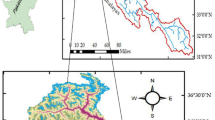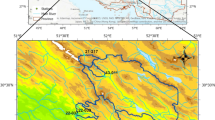Abstract
Accurate stream flow quantification and prediction are essential for the local and global planning and management of basins to cope with climate change. The ability to forecast streamflow is crucial, as it can help mitigate flood risks. Long-term stream flow data records are needed for hydropower plant construction, flood prediction, watershed management, and long-term water supply use. An accurate assessment of streamflow is considered as very challenging and critical tasks. A new predicting model is developed in this research, combining the technique of sunflower optimization (SFA) as an evolutionary algorithm with the multi-layer perceptron (MLP) algorithm to predict streamflow in Malaysia's Jam Seyed Omar (JSO) and Muda Di Jeniang (MDJ) stations. Principal component analysis (PCA) was performed on Q (t) (t: the number of the current day) before model creation to pick essential inputs for a maximum of 6 lags. With the classical MLP and two other hybrid MLP models (MLP-particle swarm optimization (MLP-PSO) and MLP-genetic algorithm (MLP-GA)), the results of the MLP-sunflower algorithm (SFA) were benchmarked. As compared to other models, the MLP-SFA could be able to reduce the Root Mean Square Error (RMSE) by a value of between 12 and 21% at the JSO station and between 8 and 24% at the MDJ station. In conclusion, this research found that combining MLP with optimization algorithms improved the precision of the stand-alone MLP model, with SFA integration being the most efficient.










Similar content being viewed by others
References
Adnan RM, Liang Z, Trajkovic S, Zounemat-Kermani M, Li B, Kisi O (2019) Daily streamflow prediction using optimally pruned extreme learning machine. J Hydrol 577:123981
Ahani A, Shourian M, Rad PR (2018) Performance assessment of the linear, nonlinear and nonparametric data driven models in river flow forecasting. Water Resour Manage 32(2):383–399
Alipour MH, Kibler KM (2019) Streamflow prediction under extreme data scarcity: a step toward hydrologic process understanding within severely data-limited regions. Hydrol Sci J. https://doi.org/10.1080/02626667.2019.1626991
Anshuka A, van Ogtrop FF, Vervoort RW (2019) Drought forecasting through statistical models using standardised precipitation index: a systematic review and meta-regression analysis. Nat Hazards 97(2):1–23
Anshuka A, Buzacott AJ, Vervoort RW, van Ogtrop FF (2020) Developing drought index–based forecasts for tropical climates using wavelet neural network: an application in Fiji. Theoret Appl Climatol 143(1):1–13
Awan JA, Bae DH (2014) Improving ANFIS based model for long-term dam inflow prediction by incorporating monthly rainfall forecasts. Water Resour Manage 28(5):1185–1199
Bonakdari H, Zaji AH (2018) New type side weir discharge coefficient simulation using three novel hybrid adaptive neuro-fuzzy inference systems. Appl Water Sci 8(1):10
Dariane AB, Azimi S (2016) Forecasting streamflow by combination of a genetic input selection algorithm and wavelet transforms using ANFIS models. Hydrol Sci J 61(3):585–600
Deng W, Yao R, Zhao H, Yang X, Li G (2019) A novel intelligent diagnosis method using optimal LS-SVM with improved PSO algorithm. Soft Comput 23(7):2445–2462
Ehteram M, Afan HA, Dianatikhah M, Ahmed AN, Ming Fai C, Hossain MS, Allawi MF, Elshafie A (2019) Assessing the predictability of an improved ANFIS model for monthly streamflow using lagged climate indices as predictors. Water 11:1130. https://doi.org/10.3390/w11061130
Ghorbani MA, Zadeh HA, Isazadeh M, Terzi O (2016) A comparative study of artificial neural network (MLP, RBF) and support vector machine models for river flow prediction. Environ Earth Sci 75(6):476
Ghorbani MA, Khatibi R, Mehr AD, Asadi H (2018) Chaos-based multigene genetic programming: a new hybrid strategy for river flow forecasting. J Hydrol 562:455–467
Ghorbani MA, Deo RC, Karimi V, Kashani MH, Ghorbani S (2019) Design and implementation of a hybrid MLP-GSA model with multi-layer perceptron-gravitational search algorithm for monthly lake water level forecasting. Stoch Env Res Risk Assess 33(1):125–147
Gomes GF, da Cunha SS, Ancelotti AC (2019) A sunflower optimization (SFO) algorithm applied to damage identification on laminated composite plates. Eng Comput 35(2):619–626
Hadi SJ, Abba SI, Sammen SS, Salih SQ, Al-Ansari N, Yaseen ZM (2019) Non-linear input variable selection approach integrated with non-tuned data intelligence model for streamflow pattern simulation. IEEE Access 7:141533–141548
He F, Zhang L (2018) Prediction model of end-point phosphorus content in BOF steelmaking process based on PCA and BP neural network. J Process Control 66:51–58
Heidari AA, Faris H, Aljarah I, Mirjalili S (2019) An efficient hybrid multilayer perceptron neural network with grasshopper optimization. Soft Comput 23(17):7941–7958
Hu T, Wu F, Zhang X (2007) Rainfall–runoff modeling using principal component analysis and neural network. Hydrol Res 38(3):235–248
Kisi O, Nia AM, Gosheh MG, Tajabadi MRJ, Ahmadi A (2012) Intermittent streamflow forecasting by using several data driven techniques. Water Resour Manage 26(2):457–474
Meng E, Huang S, Huang Q, Fang W, Wu L, Wang L (2019) A robust method for non-stationary streamflow prediction based on improved EMD-SVM model. J Hydrol 568:462–478
Mohamadi S, Ehteram M, El-Shafie A (2020) Accuracy enhancement for monthly evaporation predicting model utilizing evolutionary machine learning methods. Int J Environ Sci Technol 11:1–24
Mohammadi B, Linh NTT, Pham QB, Ahmed AN, Vojteková J, Guan Y, Abba SI, El-Shafie A (2020) Adaptive neuro-fuzzy inference system coupled with shuffled frog leaping algorithm for predicting river streamflow time series. Hydrol Sci J 65:1738–1751. https://doi.org/10.1080/02626667.2020.1758703
Osman A, Afan HA, Allawi MF, Jaafar O, Noureldin A, Hamzah FM, Ahmed AN, El-shafie A (2020) Adaptive fast orthogonal search (FOS) algorithm for forecasting streamflow. J Hydrol 586:124896. https://doi.org/10.1016/j.jhydrol.2020.124896
Pham QB, Afan HA, Mohammadi B, Ahmed AN, Linh NTT, Vo ND, Moazenzadeh R, Yu P-S, El-Shafie A (2020) Hybrid model to improve the river streamflow forecasting utilizing multi-layer perceptron-based intelligent water drop optimization algorithm. Soft Comput 24:18039–18056. https://doi.org/10.1007/s00500-020-05058-5
Rezaie-Balf M, Fani Nowbandegani S, Samadi SZ, Fallah H, Alaghmand S (2019) An ensemble decomposition-based artificial intelligence approach for daily streamflow prediction. Water 11(4):709
Sammen S, Mohamed TA, Ghazali AH et al (2017a) An evaluation of existent methods for estimation of embankment dam breach parameters. Nat Hazards 87:545. https://doi.org/10.1007/s11069-017-2764-z
Sammen S, Mohamed TA, Ghazali AH et al (2017b) Generalized regression neural network for prediction of peak outflow from dam breach. Water Resour Manage 31:549. https://doi.org/10.1007/s11269-016-1547-8
Sanikhani H, Kisi O (2012) River flow estimation and forecasting by using two different adaptive neuro-fuzzy approaches. Water Resour Manage 26(6):1715–1729
Seifi A, Ehteram M, Singh VP, Mosavi A (2020) Modeling and uncertainty analysis of groundwater level using six evolutionary optimization algorithms hybridized with ANFIS, SVM, and ANN. Sustainability 12(10):4023
Shaheen MA, Hasanien HM, Mekhamer SF, Talaat HE (2019) Optimal power flow of power systems including distributed generation units using sunflower optimization algorithm. IEEE Access 7:109289–109300
Shiri J, Kişi Ö, Makarynskyy O, Shiri AA, Nikoofar B (2012) Forecasting daily stream flows using artificial intelligence approaches. ISH J Hydraulic Eng 18(3):204–214
Suratgar AA, Tavakoli MB, Hoseinabadi A (2005) Modified Levenberg-Marquardt method for neural networks training. World Acad Sci Eng Technol 6(1):46–48
Taylor KE (2001) Summarizing multiple aspects of model performance in a single diagram. J Geophysical Res Atmos 106(D7):7183–7192
Tikhamarine Y, Souag-Gamane D, Najah Ahmed A, Kisi O, El-Shafie A (2020) Improving artificial intelligence models accuracy for monthly streamflow forecasting using grey Wolf optimization (GWO) algorithm. J Hydrol 582:124435. https://doi.org/10.1016/j.jhydrol.2019.124435
Turan ME, Yurdusev MA (2014) Predicting monthly river flows by genetic fuzzy systems. Water Resour Manage 28(13):4685–4697
Wang L, Li X, Ma C, Bai Y (2019) Improving the prediction accuracy of monthly streamflow using a data-driven model based on a double-processing strategy. J Hydrol 573:733–745
Yaseen ZM, Ebtehaj I, Bonakdari H, Deo RC, Mehr AD, Mohtar WHMW, Singh VP (2017) Novel approach for streamflow forecasting using a hybrid ANFIS-FFA model. J Hydrol 554:263–276
Zeng N, Qiu H, Wang Z, Liu W, Zhang H, Li Y (2018) A new switching-delayed-PSO-based optimized SVM algorithm for diagnosis of Alzheimer’s disease. Neurocomputing 320:195–202
Author information
Authors and Affiliations
Corresponding author
Ethics declarations
Conflicts of interest
The authors declare no conflict of interest.
Additional information
Publisher's Note
Springer Nature remains neutral with regard to jurisdictional claims in published maps and institutional affiliations.
Rights and permissions
About this article
Cite this article
Sammen, S.S., Ehteram, M., Abba, S.I. et al. A new soft computing model for daily streamflow forecasting. Stoch Environ Res Risk Assess 35, 2479–2491 (2021). https://doi.org/10.1007/s00477-021-02012-1
Accepted:
Published:
Issue Date:
DOI: https://doi.org/10.1007/s00477-021-02012-1




